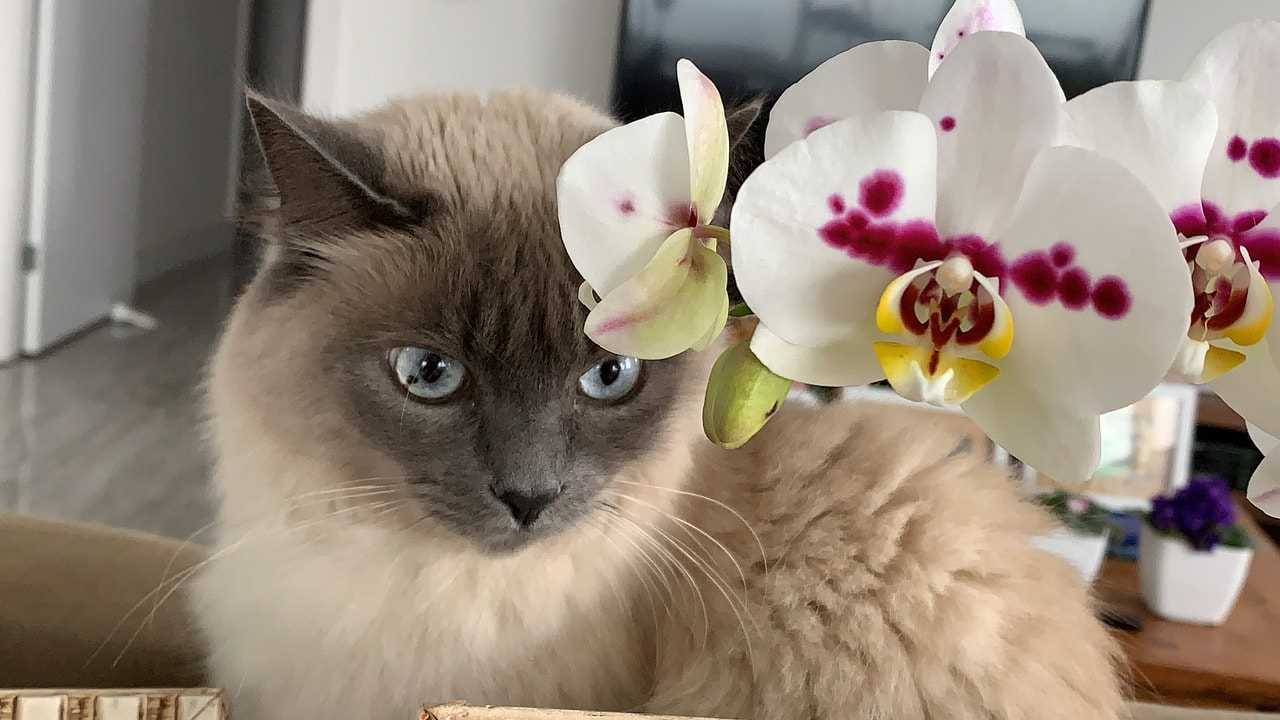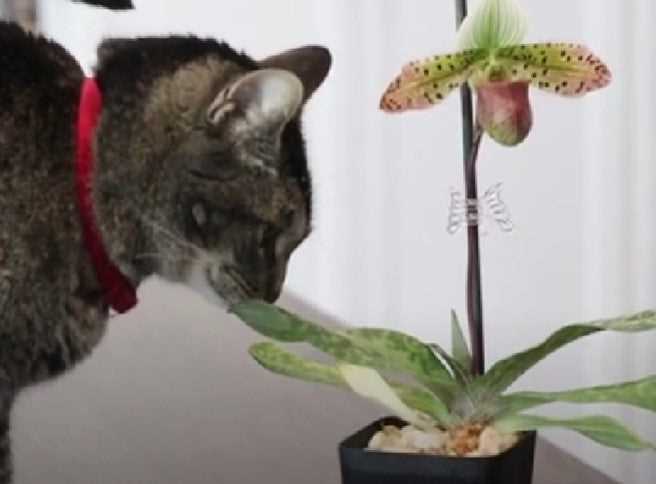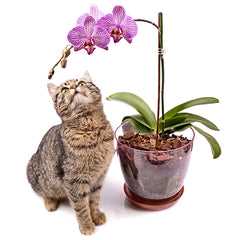As an 8-year-old Scottish Fold with a nose for safety, I can assure you that these colorful blooms are not harmful to my feline kind. While some flowers can pose a risk, the lovely varieties often found in homes are generally safe for us curious critters.
It’s important to keep an eye on what we nibble. Although these beauties won’t cause us harm, ingestion of any plant material can lead to mild digestive upset. If your whiskered companion shows signs of discomfort after a snack, it’s wise to consult a vet.
For peace of mind, make sure to keep an eye on your furry friend’s interactions with any houseplants. If there’s ever a doubt, it’s better to err on the side of caution. Happy exploring!
Is Orchid Plant Poisonous to Cats?

Rest assured, these colorful blooms are safe for our furry friends. Consuming them does not lead to toxic reactions, which is a relief for many pet owners. However, some cats might experience mild gastrointestinal upset if they nibble on them due to their sensitive digestive systems. It’s always wise to monitor your feline’s behavior after any new addition to your home.
While the flowers pose no significant danger, it’s essential to provide safe environments for our companions. Keeping an eye on their interactions with all household items can prevent any unwanted mishaps. If you notice unusual behavior or symptoms after your pet has chewed on these blossoms, consulting a veterinarian is advisable.
Additionally, if you’re curious about feline behaviors, check out this article on do cats eat their babies. You might also find it interesting to explore the reasons behind grooming habits in my post about why does my cat clean my other cat.
Identifying Non-Toxic Orchid Varieties for Pet Owners

For those who want to keep their furry friends safe while enjoying beautiful blooms, here are some varieties that pose no threat. The Phalaenopsis, commonly known as the moth flower, is a favorite among many and is completely safe for animals. Another option is the Cattleya, known for its vibrant colors and delightful fragrance.
The Oncidium, or dancing lady orchid, adds charm to any home without any risk to your pets. Additionally, the Dendrobium is another pet-friendly choice, known for its unique appearance and hardy nature.
When selecting these lovely species, always ensure you purchase from reputable sources to avoid any harmful chemicals that may have been used during cultivation. Happy shopping and enjoy your safe green space!
Signs of Orchid Plant Poisoning in Cats and First Aid Measures

If you suspect that I might have nibbled on something harmful, look out for symptoms such as vomiting, diarrhea, or excessive drooling. You may also notice me being lethargic or showing signs of discomfort, like pawing at my mouth or having difficulty swallowing. If I start behaving unusually, such as hiding or vocalizing more than usual, those could be warning signs too.
In case of suspected ingestion, it’s crucial to act quickly. First, try to determine how much of the item I might have consumed. If I’m displaying severe symptoms like difficulty breathing or seizures, immediate veterinary attention is necessary. For milder signs, you can induce vomiting if I’ve eaten something recently, but only do this after consulting a veterinarian.
Have my medical history and any information about the item ready for the vet. If possible, bring a sample or a picture of the plant to help with identification. In some cases, your veterinarian may recommend activated charcoal to limit absorption of toxins. Hydration is also key, so encourage me to drink water if I’m feeling up to it.
Remember, prevention is the best approach. Keep any potentially harmful items out of reach, and always check for safety when introducing new greenery into our home.
FAQ:
Are orchids safe for cats to be around?
Yes, orchids are generally considered safe for cats. Most types of orchids, including common house varieties like Phalaenopsis and Dendrobium, are non-toxic to felines. However, while they do not pose a direct threat, some cats may have a tendency to chew on plants, which can lead to mild stomach upset. If you notice your cat nibbling on an orchid, it is advisable to monitor them for any unusual symptoms, but in most cases, there is no cause for alarm.
What should I do if my cat eats an orchid?
If your cat has eaten an orchid, there is usually no need for panic, as orchids are typically non-toxic. However, if your cat shows signs of distress, such as vomiting, diarrhea, or lethargy, it is important to contact your veterinarian for advice. They may recommend observing your cat for a short period or bringing them in for an examination if symptoms persist. Always keep an eye on your pet’s behavior after they have ingested any plant material, as individual reactions can vary.
Video:
As an 8-year-old Scottish Fold with a nose for safety, I can assure you that these colorful blooms are not harmful to my feline kind. While some flowers can pose a risk, the lovely varieties often found in homes are generally safe for us curious critters.
It’s important to keep an eye on what we nibble. Although these beauties won’t cause us harm, ingestion of any plant material can lead to mild digestive upset. If your whiskered companion shows signs of discomfort after a snack, it’s wise to consult a vet.
For peace of mind, make sure to keep an eye on your furry friend’s interactions with any houseplants. If there’s ever a doubt, it’s better to err on the side of caution. Happy exploring!
Is Orchid Plant Poisonous to Cats?

Rest assured, these colorful blooms are safe for our furry friends. Consuming them does not lead to toxic reactions, which is a relief for many pet owners. However, some cats might experience mild gastrointestinal upset if they nibble on them due to their sensitive digestive systems. It’s always wise to monitor your feline’s behavior after any new addition to your home.
While the flowers pose no significant danger, it’s essential to provide safe environments for our companions. Keeping an eye on their interactions with all household items can prevent any unwanted mishaps. If you notice unusual behavior or symptoms after your pet has chewed on these blossoms, consulting a veterinarian is advisable.
Additionally, if you’re curious about feline behaviors, check out this article on do cats eat their babies. You might also find it interesting to explore the reasons behind grooming habits in my post about why does my cat clean my other cat.
Identifying Non-Toxic Orchid Varieties for Pet Owners

For those who want to keep their furry friends safe while enjoying beautiful blooms, here are some varieties that pose no threat. The Phalaenopsis, commonly known as the moth flower, is a favorite among many and is completely safe for animals. Another option is the Cattleya, known for its vibrant colors and delightful fragrance.
The Oncidium, or dancing lady orchid, adds charm to any home without any risk to your pets. Additionally, the Dendrobium is another pet-friendly choice, known for its unique appearance and hardy nature.
When selecting these lovely species, always ensure you purchase from reputable sources to avoid any harmful chemicals that may have been used during cultivation. Happy shopping and enjoy your safe green space!
Signs of Orchid Plant Poisoning in Cats and First Aid Measures

If you suspect that I might have nibbled on something harmful, look out for symptoms such as vomiting, diarrhea, or excessive drooling. You may also notice me being lethargic or showing signs of discomfort, like pawing at my mouth or having difficulty swallowing. If I start behaving unusually, such as hiding or vocalizing more than usual, those could be warning signs too.
In case of suspected ingestion, it’s crucial to act quickly. First, try to determine how much of the item I might have consumed. If I’m displaying severe symptoms like difficulty breathing or seizures, immediate veterinary attention is necessary. For milder signs, you can induce vomiting if I’ve eaten something recently, but only do this after consulting a veterinarian.
Have my medical history and any information about the item ready for the vet. If possible, bring a sample or a picture of the plant to help with identification. In some cases, your veterinarian may recommend activated charcoal to limit absorption of toxins. Hydration is also key, so encourage me to drink water if I’m feeling up to it.
Remember, prevention is the best approach. Keep any potentially harmful items out of reach, and always check for safety when introducing new greenery into our home.
FAQ:
Are orchids safe for cats to be around?
Yes, orchids are generally considered safe for cats. Most types of orchids, including common house varieties like Phalaenopsis and Dendrobium, are non-toxic to felines. However, while they do not pose a direct threat, some cats may have a tendency to chew on plants, which can lead to mild stomach upset. If you notice your cat nibbling on an orchid, it is advisable to monitor them for any unusual symptoms, but in most cases, there is no cause for alarm.
What should I do if my cat eats an orchid?
If your cat has eaten an orchid, there is usually no need for panic, as orchids are typically non-toxic. However, if your cat shows signs of distress, such as vomiting, diarrhea, or lethargy, it is important to contact your veterinarian for advice. They may recommend observing your cat for a short period or bringing them in for an examination if symptoms persist. Always keep an eye on your pet’s behavior after they have ingested any plant material, as individual reactions can vary.
Video:
As an 8-year-old Scottish Fold with a nose for safety, I can assure you that these colorful blooms are not harmful to my feline kind. While some flowers can pose a risk, the lovely varieties often found in homes are generally safe for us curious critters.
It’s important to keep an eye on what we nibble. Although these beauties won’t cause us harm, ingestion of any plant material can lead to mild digestive upset. If your whiskered companion shows signs of discomfort after a snack, it’s wise to consult a vet.
For peace of mind, make sure to keep an eye on your furry friend’s interactions with any houseplants. If there’s ever a doubt, it’s better to err on the side of caution. Happy exploring!
Is Orchid Plant Poisonous to Cats?

Rest assured, these colorful blooms are safe for our furry friends. Consuming them does not lead to toxic reactions, which is a relief for many pet owners. However, some cats might experience mild gastrointestinal upset if they nibble on them due to their sensitive digestive systems. It’s always wise to monitor your feline’s behavior after any new addition to your home.
While the flowers pose no significant danger, it’s essential to provide safe environments for our companions. Keeping an eye on their interactions with all household items can prevent any unwanted mishaps. If you notice unusual behavior or symptoms after your pet has chewed on these blossoms, consulting a veterinarian is advisable.
Additionally, if you’re curious about feline behaviors, check out this article on do cats eat their babies. You might also find it interesting to explore the reasons behind grooming habits in my post about why does my cat clean my other cat.
Identifying Non-Toxic Orchid Varieties for Pet Owners

For those who want to keep their furry friends safe while enjoying beautiful blooms, here are some varieties that pose no threat. The Phalaenopsis, commonly known as the moth flower, is a favorite among many and is completely safe for animals. Another option is the Cattleya, known for its vibrant colors and delightful fragrance.
The Oncidium, or dancing lady orchid, adds charm to any home without any risk to your pets. Additionally, the Dendrobium is another pet-friendly choice, known for its unique appearance and hardy nature.
When selecting these lovely species, always ensure you purchase from reputable sources to avoid any harmful chemicals that may have been used during cultivation. Happy shopping and enjoy your safe green space!
Signs of Orchid Plant Poisoning in Cats and First Aid Measures

If you suspect that I might have nibbled on something harmful, look out for symptoms such as vomiting, diarrhea, or excessive drooling. You may also notice me being lethargic or showing signs of discomfort, like pawing at my mouth or having difficulty swallowing. If I start behaving unusually, such as hiding or vocalizing more than usual, those could be warning signs too.
In case of suspected ingestion, it’s crucial to act quickly. First, try to determine how much of the item I might have consumed. If I’m displaying severe symptoms like difficulty breathing or seizures, immediate veterinary attention is necessary. For milder signs, you can induce vomiting if I’ve eaten something recently, but only do this after consulting a veterinarian.
Have my medical history and any information about the item ready for the vet. If possible, bring a sample or a picture of the plant to help with identification. In some cases, your veterinarian may recommend activated charcoal to limit absorption of toxins. Hydration is also key, so encourage me to drink water if I’m feeling up to it.
Remember, prevention is the best approach. Keep any potentially harmful items out of reach, and always check for safety when introducing new greenery into our home.
FAQ:
Are orchids safe for cats to be around?
Yes, orchids are generally considered safe for cats. Most types of orchids, including common house varieties like Phalaenopsis and Dendrobium, are non-toxic to felines. However, while they do not pose a direct threat, some cats may have a tendency to chew on plants, which can lead to mild stomach upset. If you notice your cat nibbling on an orchid, it is advisable to monitor them for any unusual symptoms, but in most cases, there is no cause for alarm.
What should I do if my cat eats an orchid?
If your cat has eaten an orchid, there is usually no need for panic, as orchids are typically non-toxic. However, if your cat shows signs of distress, such as vomiting, diarrhea, or lethargy, it is important to contact your veterinarian for advice. They may recommend observing your cat for a short period or bringing them in for an examination if symptoms persist. Always keep an eye on your pet’s behavior after they have ingested any plant material, as individual reactions can vary.






